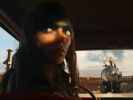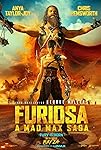Eye For Film >> Movies >> Furiosa: A Mad Max Saga (2024) Film Review
Furiosa: A Mad Max Saga
Reviewed by: Andrew Robertson

In his collection of essays South Of The West (ISBN 0-253-32581-1), Ross Gibson advances a theory about Mad Max: Beyond Thunderdome that I subscribe to. The piece, Yondering, is a reading of the third of the Max cycle that advances the notion that "the urge to narrate is shown to be a central theme of the film," that it "declares itself incontrovertibly to be mythic" (p161). He talks about how the (then trilogy) builds in unreality, and in that calls to deeper stories. The repeated notion of origin, not just within Australian colonial-myth but within the Max-eddas, is present.
When this was written in 1992, Gibson could not have known that decades later Fury Road would expand the elements he had identified, build upon audiences' cinematic awareness and the notion of story-telling. Where The Road Warrior ends with the feral kid explaining how their community came to be, where Thunderdome ends with Savannah Nix doing a 'tell', Fury Road ends with a quote from 'The First History Man'. Furiosa goes further, the repeated presence of George Shevtsov's tattooed figure an echo of Miss Giddy and more. When Dementus asks "Do you have it in you to make it epic?" it's a focus on the ideas of story-telling, of myth-cycles as much as motor-cycles.

Mad Max is a few minutes into the future still, in the middle of collapse. When Hemingway wrote about bankruptcy in The Sun Also Rises, he characterised it as "gradually and then suddenly." This is the fall, still enjoying Wile E Coyote rules. Nobody has looked down at the masses crying "Save us!" and whispered "No." By the second film we are moving away from reality into history, by the third into legend, by the fourth into folk-tale and the fifth into myth. These are tales with telling in their clutches, geared for torque and talk.
This is not one story, but five. The Pole Of Inaccessibility, Lessons From The Wasteland, The Stowaway, Homeward, Beyond Vengeance. Which of these are real? That first is a description of a set of real places, those that are furthest from anywhere by various means. The Oceanic pole is also known as Point Nemo, though it's not 20,000 Leagues from the nearest landmass. There's one in Australia, about a hundred miles from Alice Springs. That place that is hardest to get to is, for some values, home. A fruit taken from a tree and we are into a set of myths. Whatever seed is within the flesh will be carried from paradise, through the underworld, hidden in tales of children.
Within the Max stories are elements repeated. In the first Fifi talked about giving people back their heroes, the cost of the Interceptor born by bureaucrats and in the darkness, that V8 breathing in its concrete crypt. Civilisation upstairs, that garden. Brace yourself for injury detail, the shotgun betrayal, mouthfuls of fuel, "He looks silly, doesn't he, upside down?" Waking and watching, lenses of telescopes. Once Max lived by the seashore, now the shore itself is sea, endless sands, wastelands.
Gibson again: "One might call such a collection a mythology, or one might prefer to call it a history... the difference is harder to discern the closer one looks for it" (p.163). He was then discussing the films as a portrait of something external, but with time and distance they become a tapestry of something else. In those threads is a suggestion of something woven from truth. A story changed in the act of recording, like the tattoos on the history man's skin. Stars to chart courses, the pulse of posterity.
The big, the small. New stories from old. Quaden Bayles is the War Pup riding in the Bommyknocker, named variously for maces, flails, the seed pod of the New Zealand Sweetgum Tree. That on a war-rig driven by the Praetorian Jack, one of several figures who might be Max. In myths figures are disguised, re-used, there are trees here, knowledge, figures with one eye. Rictus (Nathan Jones) is older here, less built, his brother not Corpus but Scrotus, Josh Helman bringing a character created for video-game to the big screen. These different sons of a different Immortan Joe are not the same focus, their father is differently agitated. His War Rig is differently built, almost a thing alive when it has hydraulics rather than being attacked by them, those clawed arms digging with the scrabble of survival rather than any other agency.
Meet new towns, new scars in the earth, new stories of a walker (Captain or otherwise), new villains. Dementus (Chris Hemsworth) perhaps a proxy for other entities. When he is white his horde rapine and ravage with imperial intent. When he is red he promises to return wealth to the common man, to throw down leaders. When he is "the dark Dementus" his quest for moving from red to black is extractive and short-term, seeking profit in the wilderness. How much of this is real? How much of this is historic forces re-imagined as great men? How do you explain ideology in an oral tradition? No communist manifesto, just democracy manifest. A succulent Chinese meal is lost to feasts for crows, the debriding passage of maggots.
In larger journeys we will go to the Bullet Farm, to Gas Town, the Green Place, see in them echoes of the Halls of Justice, Pappagallo's Compound, May's Farm, more. Once was Sugartown, Bartertown. Everywhere has weight, new tellings. Anya Taylor-Joy a new Furiosa, Alyla Browne her younger self. Digital trickery blends their features in ways even casting cannot. Those dread letters 'AI' used in context but there is a gap between the word-burgers of machine learning and the word-salads of chat-bots. At words again Miller and Nick Lathouris, but later there are seven credited with story.
"Tell me a tale of Furiosa," they say. "Tell me how she came to leave the Green Place. Tell me how she came to the Citadel. Tell me how she came to drive the War Rig. Tell me how she came to be so armed. Tell me how she was set on her course. Tell me how she knew to find her way home. Tell me of the seed that was carried, was planted, bore fruit. Tell me true, and in the telling."
That telling and re-telling and the ideas associated is everywhere in the cycle. Is Jack (Tom Burke) an aspect of Max? He will drive your rig. Praetorians replace Imperators. Is this a new word? A new world? A new ward? In and among the job titles are credits for 'Corpse Design and Manufacture', 'Monster Trucks', 'Head of Motorbikes', 'Another Hero'. That last might not have been necessary before, but it is here. In the credits 'Vale' for those lost, some of whom are now re-cast. Lachy Hulme is an Immortan Joe, but his is a different figure in a different tale. Actually on the screen are an Octoboss (Goran Kleut) whose horns sound across the landscape. There are his Mortiflyers, the gyro-captain's legacy re-written in silk and chute.
To build on Gibson's thesis I would argue that each Max film is a further re-telling of the same events at generational remove. News becomes history, history becomes folk tale, folk tale becomes legend, legend becomes myth. A biker gang escapes the law but not justice. A community is menaced by scavengers. A war between a city and its shadow. An escape. All of these again, but bigger. The same figures re-drawn, the same arms raised in anger and worse. Through them the figure of Max as an observer, he was changed once but seldom since. Even when he wears another's face there is something in set and stance and brace. He looks down from the hill but now is not when he joins this story. He has looked down from other hills. He will look down again.
The vehicles, six-wheeled and three-headed, breathing under the ministrations of black-thumbs, ragged and ornate. Gibson uses 'baroque' to describe the sensibilities of Thunderdome and there is ever more craft in costume and car in Fury Road and Furiosa more. Effort off the screen becomes engagement upon it. Drink in that detail, it will sustain you more readily than water. Furiosa's prosthetic is now more magical than practical, another working of legend. Hear a radial aircraft engine draw a chariot, hear a single-cylinder aero cutting a different course.
From every detail springs a story, but the temptation to explain is a trap. Note that on a chest it says 'effective merchandising, go back to try to read a bumper sticker, see and see again. You've seen it all before, but that's its strength. That cranked footage, those desperate eyes, the obscuring sand. Recognise the names of Mr Norton and Mr Harley, Mr Davidson too. Gaze upon the tentacular Priscilla of a road war. Make it real, make it royal, make it roar. Since we have had stories in English we have had visits and revisits. Beowulf went to Heorot and back, later bearded a dragon in its den. His story's first word was "Hwaet!", but with mechanical rattle this story's first is V8.
Reviewed on: 28 May 2024


















